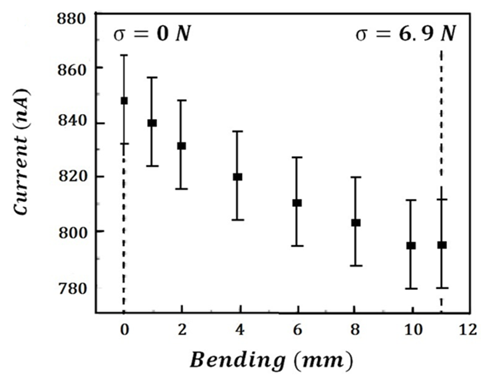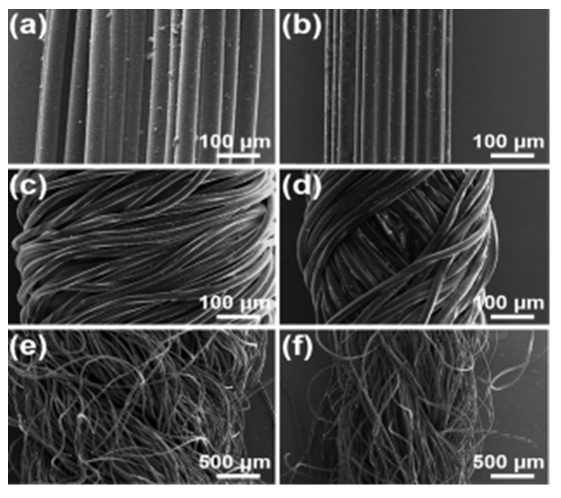-
Paper Information
- Paper Submission
-
Journal Information
- About This Journal
- Editorial Board
- Current Issue
- Archive
- Author Guidelines
- Contact Us
International Journal of Materials Engineering
p-ISSN: 2166-5389 e-ISSN: 2166-5400
2020; 10(1): 1-12
doi:10.5923/j.ijme.20201001.01

Graphene and Its Industrial Applications – A Review
Belal G. Nassef, Galal A. Nassef, Mohamed A. Daha
Production Engineering Department, Alexandria University, Alexandria, Egypt
Correspondence to: Belal G. Nassef, Production Engineering Department, Alexandria University, Alexandria, Egypt.
| Email: |  |
Copyright © 2020 The Author(s). Published by Scientific & Academic Publishing.
This work is licensed under the Creative Commons Attribution International License (CC BY).
http://creativecommons.org/licenses/by/4.0/

Graphene has been recently introduced as a promising material for various applications due to its outstanding mechanical, electrical, and thermal properties. It is classified as an allotropic form of carbon with the size of a single layer of graphite. This paper provides an extensive review regarding different critical applications of graphene including three categories namely: energy harvesting, strain sensors technology, and steel industry. The paper highlights what has been traversed in each category and provides an insight for researchers on what still needs to be investigated, which would open new horizons for scientific research and industrial applications. This field of research is expected to yield results that will have a considerable advance specially in 3D strain sensing technology. Also a special attention is given to the application of graphene in steel coating, steel welding, and lubrication.
Keywords: Graphene, Energy Harvesting, Strain Sensors, Steel Industry
Cite this paper: Belal G. Nassef, Galal A. Nassef, Mohamed A. Daha, Graphene and Its Industrial Applications – A Review, International Journal of Materials Engineering , Vol. 10 No. 1, 2020, pp. 1-12. doi: 10.5923/j.ijme.20201001.01.
Article Outline
1. Introduction
- Graphene is a 2D transparent nanomaterial that is both durable and flexible. It is classified as an allotropic form of carbon with the size of a single layer of graphite. In 2004, graphene was first introduced to the world when Andre Geim and Kostya Novoselov managed to segregate a single atomic layer of carbon. Since then, this promising material has drawn the attention of many researchers in the domains of materials science and mechanical engineering to manufacture and exploit it. There are two main techniques to fabricate graphene; the first is Top-down technique by breaking down of graphite into graphene using external mechanical or electrical, while the second way is Bottom-up by building up graphene from molecular building blocks or from carbon sources.Novoselov et al. [1] compared four different synthesis processes of graphene with respect to the obtained quality and price as shown in figure (1). A list of characteristics such as the size of layer and applications were used to differentiate between the syntheses methods [2]. For coating applications, it was found, among other fabrication methods that the optimal fabrication methods of graphene films are chemical vapor deposition (CVD) and liquid phase exfoliation methods because both methods are scalable and show relative higher cost-efficiency than other methods. Graphene can either be used as a surface coating material as a composite or in a pristine form to improve corrosion resistance [3] & [4]. It is chemically inert and has impermeability to most of gases. These outstanding properties reinforce its chances to be the most suitable material in coating purposes [5,6].
 | Figure 1. A comparison between various methods for production of graphene regarding to the price and quality [1] |
2. Graphene Synthesis Methods
- There are two different approaches for graphene manufacturing as shown in figure (2). The first one is Top-down approach, in which, graphite is broken down into graphene flakes using mechanical or electrical external forces. The second approach runs in an opposite way, which is achieved by building up graphene from molecular building blocks or from carbon sources [29]. In order to fulfil industrial needs, there are two important factors concerning scalability when focusing on the proficiency of any synthetic route to graphene. First one, a process must produce enhanced quality in the 2D crystal lattice to ensure high mobility. In the second one, the method must provide fine control over crystallite thickness in order to deliver uniform device performance [30].
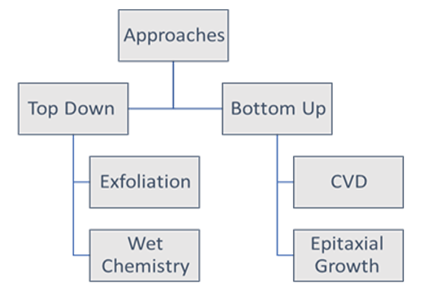 | Figure 2. Different routes for graphene production |
2.1. Exfoliation Method
- This method has two main branches scotch tape and liquid phase exfoliation.In scotch tape technique, multiple layers of graphene stick to the tape after peeling it off the graphite. By repeated pealing, the number of graphene layers is reduced. Commercial solvents such as acetone are used to remove the tape glue. Finally, the tape is removed by unused peeling process. This method is featured by low complexity, high quality of produced graphene, lack of controllability, and limited amount of produced graphene [31].Liquid phase Exfoliation (LPT) technique is based on dispersing the graphite in an organic solvent which has nearly the same surface energy as graphite [32]. The solution is sonicated in an ultrasound bath for several hundred hours or by applying a potential difference [33]. After the dispersion, thicker flakes are to be disposed by centrifugation of solution. The quality of obtained graphene is nearly the same as in scotch tape technique, whereas the amount of produced graphene is much higher with lower complexity.
2.2. Wet Chemistry
- The most common technique here is called "Hummer's Method". The benefits of the hummer's method are its low-cost and massive productivity [30]. This technique is achieved by adding graphite powder to sodium nitrate. Afterwards, a concentrated sulphuric acid is added during stirring followed by adding KMnO4 progressively to the mixture while maintaining low temperature (less than 20 °C) to prohibit overheating and predicted explosion. The mixture is stirred for 12 hrs. while keeping the temperature at 30°C. Then, water is added under potent stirring to dilute the mixture. To ensure the completion of reaction with KMnO4, the suspension should be treated with 30% H2O2 solution. Finally, graphene oxide sheets are, thus, obtained by using HCl and H2O to wash the resulting mixture, which is followed by filtration and drying [34].
2.3. Epitaxial Growth
- Graphene can be synthesized by heating SiC precious stone at a somewhat high temperature (~2000 K) in ultra-high vacuum. Multilayered graphene structure is yielded after desorption of Si from the top layers of SiC crystalline wafer and the produced structure acts like graphene [35]. Controlling the obtained number of layers occurs by constraining time or temperature of the warmth treatment. The ability to produce large amounts of graphene through epitaxial growth is much lower compared to liquid-phase exfoliation. Also, the intricacy of this technique is comparatively low. Moreover, the quality of produced graphene is lower as compared to the exfoliated one [31].
2.4. Chemical Vapor Deposition (CVD)
- Graphene layers are grown in a closed chamber by exposing of a Ni film to a mixture of H2, CH4, and Argon at about 1000°C (Samples are heated by filament or plasma) [36]. After decomposing the methane into C and H2, the hydrogen evaporates followed by the diffusion of carbon atoms into Ni substrate surface. By cooling down in an Ar atmosphere, a layer of graphene begins to grow on the surface. Furthermore, controlling the pattern of the Ni layer is used to control the shape of the produced graphene. It is possible to use a polymer support over which graphene layers could be transferred. After the Ni substrate is etched, the polymer support is peeled off resulting stamped graphene over the substrate. This method can be used to decrease the resistance by stamping of graphene layers on each other [31].It was also reported that Ni has a good solubility for carbon atoms and this solubility depends on the cooling rate. At low cooling rates, there is no segregation because C atoms have sufficient time to diffuse through Ni substrate. At moderate cooling rates, C atoms begin to segregate and form graphene. At higher cooling rates, C atoms clearly segregate out of Ni, forming a defective graphitic structure with lower crystallinity [37]. Moreover, the replacement of nickel substrate by a copper one had also been reported to result in a single-layer graphene with a few-layer graphene structure (less than 5%), which didn’t grow larger with time [38].Wang et al. [39] had demonstrated a new method of growing substrate-free few-layered graphene. MgO-supported Co catalysts were used to grow graphene in a ceramic boat (at 1000°C for 30 min) under CH4 and Ar gas envelope of 1:4 volume ratio and total 375 mL/min flow rate. After the reaction, MgO and Co were washed from the product by using concentrated HCl, followed by rinsing with clean distilled water and drying at 70°C. They confirmed, by microstructure characterization using SEM, HRTEM and Raman spectroscopic, the presence of rippled graphene sheets, containing at least five layers.
3. Recent Trends of Applications
- It is becoming a fact that graphene is considered as an exact two-dimensional gapless semiconductor and the most durable material ever measured which can endure up to 25% tensile elastic strain [40]. As mentioned in the previous sections, the exceptional corrosion resistance property makes it the best candidate as a corrosion barrier for steel industry. The new trends of applications are summarized in the upcoming sections.
3.1. Strain Sensors
- Recent research efforts focused in utilizing Graphene as an elastic material with weak sheet resistance in the manufacturing of improved strain sensors [41-43]. Moreover, 2D nanoflakes usually offer a piezoresistivity which is more than nanowires by one order of magnitude, as their electrical percolation network is hugely suffers from geometrical discontinuities [41]. The implementation of this idea on a large scale is constrained by economic challenge manifested in high production cost of graphene and CNTs. Carbon nanotubes and graphene have shown outstanding mechanical, electrical, piezoresistive and other physical properties which make them suitable for several applications in recent years. However, compared to CNTs, graphene have attracted enormous attention due to an ideal 2D structure which has its own merits in scalable devices fabrication through top-down approaches [40,44]. Moreover, graphene is a lower priced material with higher availability in a large-scale industrial production compared to CNTs. There are different fabrication procedures and structures in graphene-based strain sensors providing various properties suitable for different applications (0D fullerene, 1D fiber, 2D film, 3D porous structure) [45]. The 3D graphene-based structures are very important part in the manufacturing of strain sensors because they can be massively produced in large quantities. Also, these structures can be stretched in all Cartesian axes and detects tiny or large force with ultrahigh sensitivity [45].Fu et al. fabricated a strain sensor using CVD-grown graphene with higher sensitivity (GF~151) [46]. Also, J. Zhao et al. developed a graphene-based strain sensor with a sensitivity factor of more than 300 [47]. They illustrated the piezoresistive behavior of the graphene films by using a charge tunneling model. Bao et al. had fabricated a more advanced strain sensor with a sensitivity factor of around 150 through using a sprayed solution technique [22]. The properties of the graphene films were explained through a percolation networks model. In addition, Li et al. created graphene woven fabrics with a gauge factor of 103 under 2-6% strains and 106 under higher strains [48]. Wang and collaborators [49] fabricated a composite of graphene Nanoplatelets with PDMS through simple sonication and molding processes. This device reached gauge factors of approximately 230 at a GnPs concentration of around 8 vol %, and within a strain of 2%. Yong Lin et al. [50] fabricated a highly stretchable strain sensor with a high gauge factor from graphene elastomer composites by subjection functionalized graphene into the mixture of NR latex (NRL) and SBR (SBRL) latex creating electrostatic interactions between functionalized graphene (f-GE, positively charged) and NR latex particles (negatively charged) and they found that the fabricated strain sensors manifested outstanding characteristics such as good stretchability (up to 120%), high sensitivity (GF~82.5) and acceptable fatigue life (about 300 cycles) even when strained up to 100%, which makes able to detect and measure human motion under large strain. Moreover, the double-interconnected GE network enables the strain sensors with the excellent performances.Dong Zhang, et al. [18] had synthesized novel type of strain sensors by using a spray coating technique to fabricate a sandwich-structured composite through sandwiching polymer layers (Styrene-Acrylate emulsion) between graphene layers and the substrate (stretchable rubber) and this composite was tested by digital multimeter to measure electrical resistance during tensile test. They discovered that the manufactured strain sensors which could endure a large tensile strain (25% strain) demonstrated high sensitivity to mechanical strain with GF of 6-35. Also, the resistance of the samples decreased with the increasing of the distribution density from 0.93g/m2 to 1.48 g/m2, and kept almost unchanged at the distribution density from 2.59 g/m2 to 2.96 g/m2 as shown in figure 3. In Addition, the results demonstrated that these graphene composites were more sensitive compared to those without the polymer layers. Thus, the internal crack size in the composite films progress with time as a result of increasing strain. This results in a decrease of conductive paths and an increase of the sensitivity factor.
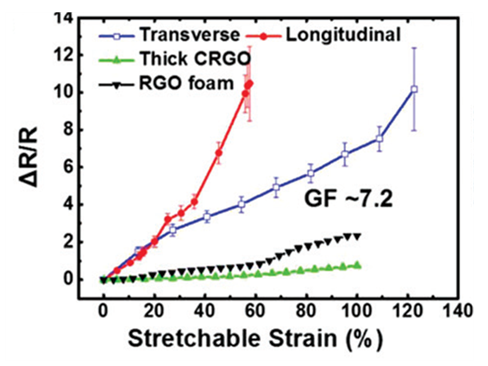 | Figure 6. The relative resistance change ratio versus strain curves of various strain sensors [58] |
3.2. Energy Harvesting Applications
- Recently, ferroelectric materials have attracted enormous attention because of their application in energy harvesting owing to its piezoelectric nature. In the decade before this, energy harvesting from piezoelectric materials had been largely based on bulk materials and have usually been of cantilever type, which requires special designs to operate at lower frequencies (in a frequency range < 100 Hz) [61,62].In the same track of research, Wang and Song [63] introduced a nanogenerator, to represent the energy harvesting devices which convert mechanical energy into electrical energy from Nano-piezoelectric materials utilizing low frequency mechanical vibrations available in ambient atmosphere and human body motions. In general, the inorganic materials such as lead zirconium titanate, barium titanate, and so on have higher piezoelectric coefficients but are brittle, whereas the polymer ferroelectrics, poly (vinylidene fluoride-trifluoroethylene) [PVDF-TrFE], have lower piezoelectric coefficients but are flexible and can endure higher strains compared to inorganic types [64,65].Venkateswarlu Bhavanasi et al. [66] investigated energy harvesting behavior of flexible PVDF-TrFE bilayer films with graphene oxide synthesized using drop casting technique followed by vacuum drying. They had chosen PVDF-TrFE due to its high piezoelectric coefficients among polymer ferroelectrics and graphene oxide as GO layers acquire negative charges owing to the existence of functional groups. Utilizing the charge on GO, an electrostatic nanogenerator has been fabricated to retain and convert the energy taken from mechanical vibrations. They observed that the adhesion of the GO films with the non-poled PVDF-TrFE films is poor due to the hydrophobicity and chemical inertness of PVDF-TrFE. In Addition, they observed that the obtained film shows outstanding energy harvesting leverage with power output of about 4.41 μWcm−2 and a voltage output of about 4 V compared to poled PVDF-TrFE films alone (power output of 1.77 μWcm−2 and voltage output of 1.9 V) owing to the improved elastic modulus of the bilayer films, the effect of electrostatic contribution from GO layers, and residual tensile stress.Sanghoon Park et al. [67] fabricated a PVDF film based piezoelectric generator with graphene electrodes on both sides of the PVDF film. The film was placed vertically between graphene sheets from both sides after dipping it into the water. After that they compared energy harvesting performance of the film with PVDF film with metal electrodes by fixing the film in a bar frame which was weighed about 70 g and had additional hung weights to apply longitudinal tensile stress. The samples were acoustically excited using a loudspeaker by tuning the excitation frequency between 100 Hz to 300 Hz and the excitation signals amplitude remained constant at 5 V. A decibel meter was used to measure loudness (105 to 110 dB) at 10 cm distance. They observed that devices based on metallic electrodes produced a higher output power as compared to graphene electrodes. Also, they concluded that the thin piezo-film was more effective in converting acoustic waves into electrical charge because free standing thin film is more flexible and more sensitive to the acoustic waves.Manoj Kandpal et al. [68] reported a robust and a low-cost spin coating approach for fabrication of large area flexible piezoelectric nanocomposite generator device for harvesting bio-mechanical motions based on additions of ZnO and BaTiO3 fillers on SU-8 matrix. They investigated the effect of adding graphene on these piezoelectric nanocomposites and they found that the average signal magnitude over the cycles was ~182 mV, ~592 mV without graphene for ZnO and BaTiO3 respectively. Whereas, with the addition of graphene it spiked up significantly to ~385mV, ~1.5 V for ZnO and BaTiO3 films.Liangke Wu et al. [69] fabricated piezoelectric nanocomposite films by adding reduced graphene oxide to poly(vinylidene fluoride) and they found that Compared to pristine poly(vinylidene fluoride) films, the open-circuit voltage, the density of harvested power of alternating current, and direct current of the poly(vinylidene fluoride)/reduced graphene oxide nanocomposite films improved by 105%, 153%, and 233%, respectively, indicating the suitability of this nanocomposite films for a broad range of applications.
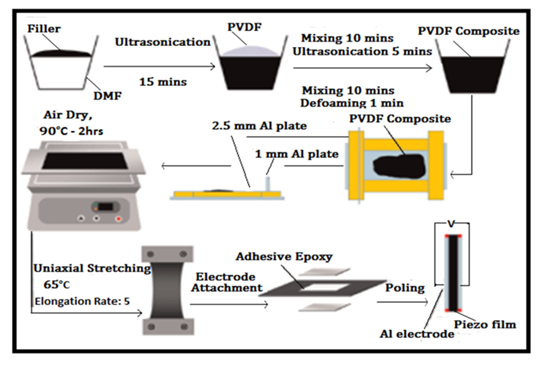 | Figure 7. Fabrication process of PVDF/rGO nanocomposite films. PVDF: poly(vinylidene fluoride); rGO: reduced graphene oxide; DMF: dimethylformamide [69] |
3.3. Graphene in Steel Industry
3.3.1. Steel Coating
- Steels are iron alloys combined with carbon and other alloying elements of appreciable concentrations. These alloys are widely used in different industrial applications such as shells in automotive industry, supporting columns and tableware [70]. Graphene is introduced as a coating material for different types of steels seeking improvement not only in corrosion resistance but also in the electrical properties to open the scientific research gates and provide strong chance for graphene to be used extensively in industrial applications in order to increase efficiency and quality of produced steels. Graphene exhibits superior impermeability compared to the most commonly used traditional anticorrosive coatings such as polymer coatings. Also, graphene is environmental-friendly, and offers green, alternative solutions to the dangerous coatings, such as chromium-based coatings [71].To the best of authors' knowledge graphene possess a weak adhesion on metal substrate which affects its performance during harsh working conditions. Hence, researchers are seeking to manufacture a long-term graphene anticorrosive coating. Moreover, the growth of graphene on some metals and alloys (Fe, Mg, Al) is quite challenging due to poor catalytic activity [71]. These challenges could be avoided through using multi-layer graphene coatings (MLG) rather than SLG because in MLG the diffusion pathway of some of corrosion species is enhanced compared to SLG. Also, polymer-graphene hybrid composites could overcome some of challenges mentioned above as polymer enhances the adhesion between coating and metal surface without using very high temperature to avoid deterioration of mechanical properties. Moreover, polymer matrix acts as insulator that insulates graphene from metal surface to avoid galvanic corrosion. Also, the soft polymer helps graphene to coat rough surfaces [71].Ludovic F. Dume´e et al. [72] investigated the growth of 3D nano-flakes graphene on porous stainless steel substrate via CVD process and they observed that the graphene flakes act as a corrosion inhibitor by hindering the diffusion of corrosive agents towards sensitive surfaces. They also found that the pitting point is shifted by 50% suggesting that the graphene is acting primarily as an anodic barrier to ion diffusion towards the underlying metal surface thus decreasing the corrosion rate by reducing the kinetics of metallic ionization.Jayanta Mondal et al. [73] developed a corrosion inhibiting composite coating composed of graphene oxide and polypyrrole for 304 stainless steel substrate. The samples were tested using G48A salt test analysis by immersing samples into 6% ferric chloride aqueous solution for six days. They observed that the coating was more stable more than 72 hrs and after 144 hrs the coating structure deteriorated in some places and a breakdown occurred. Also, from Tafel plot they found that Ecorr of the GO/PP coating increases by nearly 6.3% compared to bare steel surface (-9 increases to 48 mV).Tong Y. et al. [74] applied graphene and graphite onto cold rolled steel (Black Plate) as a conductive coating through EPD (Electro Phoresies Deposition) process. After investigation they found that the graphite coated steel had an electrical conductivity that was higher by 10 times compared to that of the steel substrate. Also, the optimum thermal treatment parameters was found to be 580°C for almost five minutes and the best EPD parameters are 0.175 mg/ml iodine concentration, and 20 to 40V EPD voltage for 1-minute deposition time.
 | Figure 8. Galvanostatic electrochemical deposition of polypyrrole (curve 1) and graphene oxide-polypyrrole composite (curve 2) on AISI type 304 stainless steel substrates [73] |
3.3.2. Steel Welding
- Recently, graphene has been used as a reinforcement material during the welding processes [78-81], due to its high electrical and thermal conductivity, excellent tribological behavior [82], and low thermal expansion coefficient. Hadi Jafarlou et al. [83] used graphene as reinforcement in welding low carbon steel joints via SMAW technique and they observed that the yield strength was improved by 3–45% and the ultimate tensile strength was enhanced by 5–22%. They also found that the enhancement in mechanical properties in terms of strength and hardness values was attributed to the refinement of ferrite grains made by graphene additions.Tanmoy Das et al. [84] added graphene on AISI-1008 steel surface by drop-coating method and the coated steel was joined with aluminum plates (Al-1100 alloy) via resistance spot welding technique. They observed up to 124% enhancement in strength values. Also they concluded that the enhancement in hardness values was attributed to the formation of intermetallic compounds (IMCs) which couldn’t be avoided by graphene additions and these IMCs could bear shear stresses only.In an attempt to improve the mechanical properties of mild steel welded joints, the influence of adding graphene oxide and reduced graphene oxide were tested during flux cored arc welding process [85]. It was found that 10mg/ml of RGO enhanced the mechanical properties in terms of hardness and tensile strength by about 38.4% and 25% respectively due to the refinement of ferrite grains.
3.3.3. Lubrication of Steels
- It was found that one third of the total energy consumption throughout the world lost due to poor friction and wear properties of material and the most common failure mechanisms of the 80% of the fabricated parts were wear and tear [86,87]. It was also demonstrated that the friction and wear have applications not only in operation of industrial machines and part life, but also in biological and human ones [88,89]. In order to enhance the tribological behavior and reduce energy losses of any application, a gaseous, liquid or solid lubricant should be used as the lubricant role is to reduce the metal to metal contact by forming a low shear boundary film between rubbing surfaces to increase the durability of the part [90].Graphene has an ultrathin structure (about 0.34nm thick) which makes it the best candidate in some nano and micro scale systems such as electromechanical systems to decrease friction, and wear between rotating and sliding parts [90]. Several studies are conducted concerning the graphene’s frictional mechanism based on some of the computational methods at different scales ranging from nano up to macro [91-96], as shown in figure (9).
 | Figure 9. Number of research articles published in literature on the topic “graphene nanolubricants” [97] |
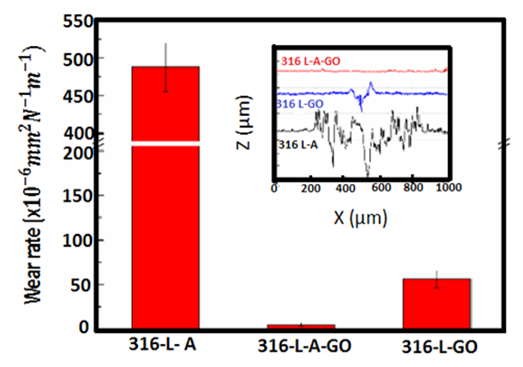 | Figure 10. A comparison between the wear rates and the corresponding wear tracks (inset) [101] |
4. Conclusions
- Graphene is a promising material that reached high apex in energy storage applications. Moreover, it is used in strain sensors as it enabled considerable high gauge factors and sensitivity. Recently, graphene is introduced as a coating material for different types of steels seeking improvement not only in corrosion resistance but also in the electrical properties which provides strong chance to increase efficiency and quality of produced steels. Another track of research investigated the use of graphene as a reinforcement material through addition to flux during the welding processes to enhance mechanical properties of steel. Considerable interest is currently given by researchers to the efficiency of graphene as an additive to lubricants to enhance tribological properties in different applications such as metal cutting and lubrication of internal combustion chamber liners.Future work should solve the following points: • The inadequate dispersion or agglomeration of graphene which leads to inhomogeneous structure where agglomerated GNPs can act as stress concentrators. Moreover, this also impairs the efficiency of lubrication.• The unclear strain sensor mechanism and this is because the difference in graphene film quality produced by different fabrication processes.• CVD-grown graphene sensors are fabricated through an expensive and complicated process that is unsuitable for practical applications.• Controlling the sensitivity of the sensor for measuring diverse human body motions remains challenging. • The effect of graphene on steel weldments needs more investigations.• There is a need to develop a correlation between wear volume and friction coefficient for graphene as a nano lubricant.
 Abstract
Abstract Reference
Reference Full-Text PDF
Full-Text PDF Full-text HTML
Full-text HTML
